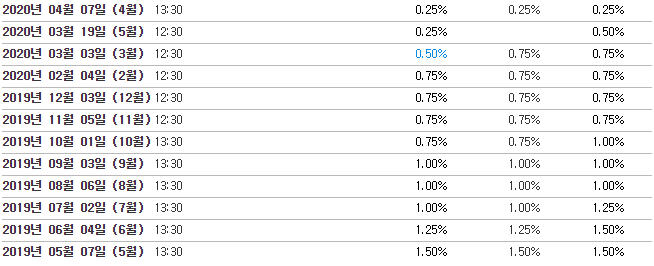호주 RBA 기준금리동결-20200407
 FOHUNTERS™
FOHUNTERS™
| 기준금리 | 0.25% |
|---|
RBA기준금리 추이

Statement by Philip Lowe, Governor: Monetary Policy Decision
At its meeting today, the Board reaffirmed the targets for the cash rate and the yield on 3-year Australian government bonds of 25 basis points, as well as the other elements of the package announced on 19 March 2020.
The coronavirus remains first and foremost a very major public health issue, but it is also having very significant effects on economies and financial systems around the world. Many countries are expected to experience large economic contractions as a consequence of the public health response. Large increases in unemployment are also expected. Once the virus is contained, a recovery in the global economy is expected, with the recovery supported by both the large fiscal packages and the significant easing in monetary policy that has taken place.
Financial market volatility has been historically high and many markets around the world have been dislocated. There are, however, some signs that markets are working more effectively than they were a few weeks ago. This improvement partly reflects the substantial measures undertaken by central banks.
In Australia, the yield on 3-year Australian Government bonds is now around the target level set by the Board and the functioning of the government bond markets has improved. The Bank will do what is necessary to achieve the 3-year yield target, with the target expected to remain in place until progress is being made towards the goals for full employment and inflation. Since this target was introduced, the Bank has bought around $36 billion of government bonds in secondary markets, including bonds issued by the states and territories. The Bank will continue to promote the smooth functioning of these important markets. If conditions continue to improve, though, it is likely that smaller and less frequent purchases of government bonds will be required.
The Bank has injected substantial liquidity into the financial system through its daily open market operations to support credit and maintain low funding costs in the economy. It will continue to ensure that the financial system has sufficient liquidity. Given the substantial liquidity that is already in the system and the commencement of the Term Funding Facility, the daily open market operations are likely to be on a smaller scale in the near term. Operations at longer terms will continue, but the frequency of these operations will be adjusted as necessary according to market conditions.
The first drawings under the Term Funding Facility were made yesterday. This facility will help lower funding costs across the banking system and provides an incentive for lenders to support credit to businesses, especially small and medium-sized businesses. Authorised deposit-taking institutions have access to at least $90 billion in funding under this facility.
There is considerable uncertainty about the near-term outlook for the Australian economy. Much will depend on the success of the efforts to contain the virus and how long the social distancing measures need to remain in place. A very large economic contraction is, however, expected to be recorded in the June quarter and the unemployment rate is expected to increase to its highest level for many years.
The coordinated monetary and fiscal response, together with complementary measures taken by Australia's banks, will soften the expected contraction and help ensure that the economy is well placed to recover once the health crisis has passed and restrictions are removed. These various responses are providing considerable support to Australian households and businesses through what is a very difficult period. The Australian financial system is resilient. It is well capitalised and in a strong liquidity position, with these financial buffers available to be drawn down if required to support the economy.
The Board is committed to doing what it can to support jobs, incomes and businesses as Australia deals with the coronavirus. The comprehensive policy package announced last month will also support the expected recovery. The Board will not increase the cash rate target until progress is being made towards full employment and it is confident that inflation will be sustainably within the 2–3 per cent target band.
The Board wishes the best to all Australians as our country deals with this very difficult situation.
댓글 2
댓글 쓰기

연관기사 : RBA, 기준금리 0.25%로 동결…"2분기 GDP 크게 위축"(상보) 연합인포맥스






원문링크 : https://www.rba.gov.au/media-releases/2020/mr-20-11.html